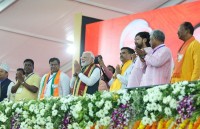 Aditya L1
Photo Courtesy: UNI
Aditya L1
Photo Courtesy: UNI
Aditya-L1 begins collecting scientific data at distances greater than 50,000 km from Earth
India's first Solar exploratory mission Aditya-L1 to study the Sun, has commenced collecting scientific data at distances greater than 50,0000 km from Earth.
The sensors of the STEPS instrument have begun measuring supra-thermal and energetic ions and electrons at distances greater than 50,000 km from Earth, ISRO said on Monday, in a Mission update.
This data helps scientists analyze the behaviour of particles surrounding Earth.
ISRO posed on X : "Aditya-L1 has commenced collecting scientific data."
"The sensors of the STEPS instrument have begun measuring supra-thermal and energetic ions and electrons at distances greater than 50,000 km from Earth," it said.
"This data helps scientists analyze the behaviour of particles surrounding Earth," it added.
ISRO also released a graphical figure that displays variations in the energetic particle environment, collected by one of the units.
"It showed variation in integrated counts over time recorded by one of the STEPS Sensors on September 10, 2023," ISRO said.
The Supra Thermal & Energetic Particle Spectrometer (STEPS) instrument, a part of the Aditya Solar Wind Particle EXperiment (ASPEX) payload, has begun collection of scientific data.
STEPS comprises six sensors, each observing in different directions and measuring supra-thermal and energetic ions ranging from 20 keV/nucleon to 5 MeV/nucleon, in addition to electrons exceeding 1 MeV.
These measurements are conducted using low and high-energy particle spectrometers.
The data collected during Earth’s orbits helps scientists to analyse the behaviour of particles surrounding the Earth, especially in the presence of the magnetic field of Earth.
STEPS was activated on September 10, 2023, at a distance greater than 50,000 km from Earth. This distance is equivalent to more than eight times the Earth's radius, placing it well beyond Earth's radiation belt region.
After completing the necessary instrument health checks, data collection continued until the spacecraft had moved farther than 50,000 km from Earth.
Each unit of STEPS is operating within normal parameters.
A figure displays measurements depicting variations in the energetic particle environment within Earth's magnetosphere, collected by one of the units. These STEPS measurements will persist during the cruise phase of the Aditya-L1 mission as it progresses towards the Sun-Earth L1 point.
They will continue once the spacecraft is positioned in its intended orbit and the data collected around L1 would provide insights into the origin, acceleration and anisotropy of solar wind and space weather phenomena.
STEPS was developed by the Physical Research Laboratory (PRL) with support from the Space Application Centre (SAC) in Ahmedabad.
(With UNI inputs)
Top Headlines
-
News
CSR in the Crossfire: Professor and practitioners debate over ethics in India Inc. at Kolkata's MCHD talk
October 24, 2025
-
News
Jashanpreet Singh Case: California under fire for licensing undocumented truck driver
October 24, 2025
-
News
India upgrades Technical Mission in Kabul to Embassy, days after Muttaqi's visit to New Delhi
October 22, 2025
-
News
Pakistan, Afghanistan agree to 48-hour ceasefire after deadly border clashes
October 15, 2025
-
News
Afghan Taliban, Pakistan exchange gunfire, dozens killed
October 15, 2025
-
News
Trump hails Netanyahu in Israel after hostage release, declares historic dawn of a new Middle East
October 13, 2025
-
News
Historic dawn of a new Middle East: Donald Trump addresses Israeli Parliament
October 13, 2025
-
News
Shah Rukh Khan receives maiden National Award from President Droupadi Murmu
September 23, 2025
-
News
Kolkata: Ahiritola Yubak Brinda invites Auram to make jewellery for Ma Durga and her family
September 20, 2025
-
News
Israel-US alliance 'never been stronger', Netanyahu says as State Secretary Rubio visit for talks
September 15, 2025





